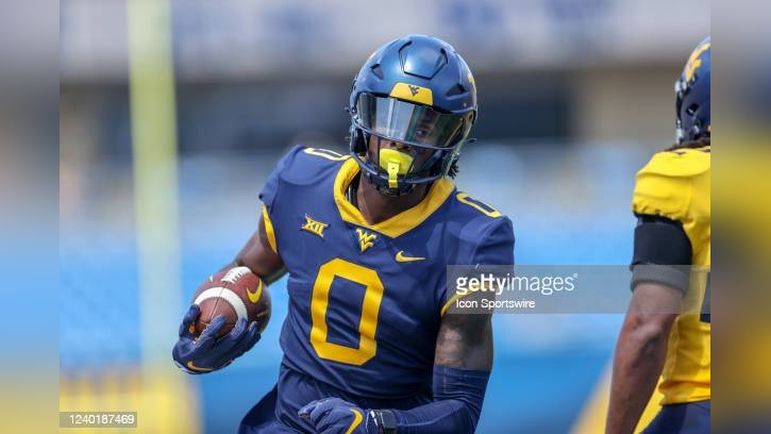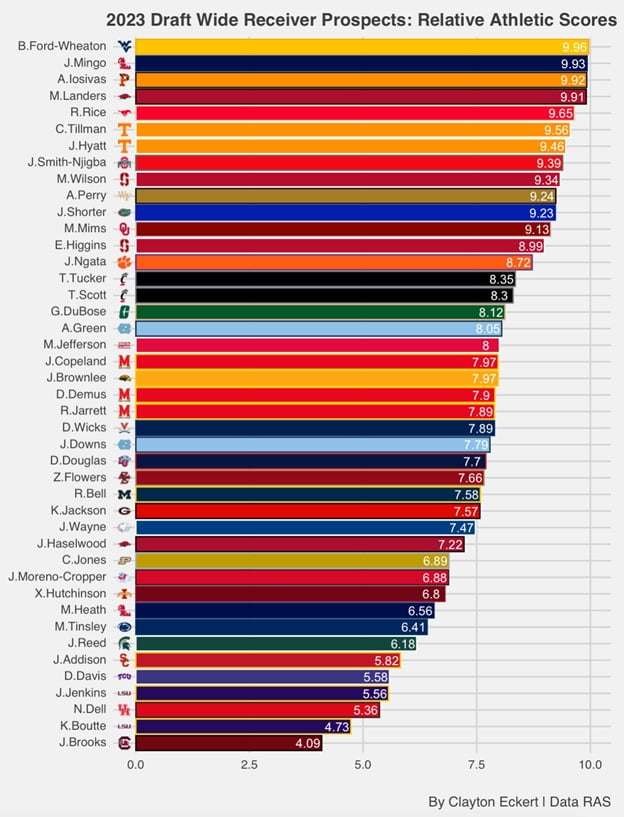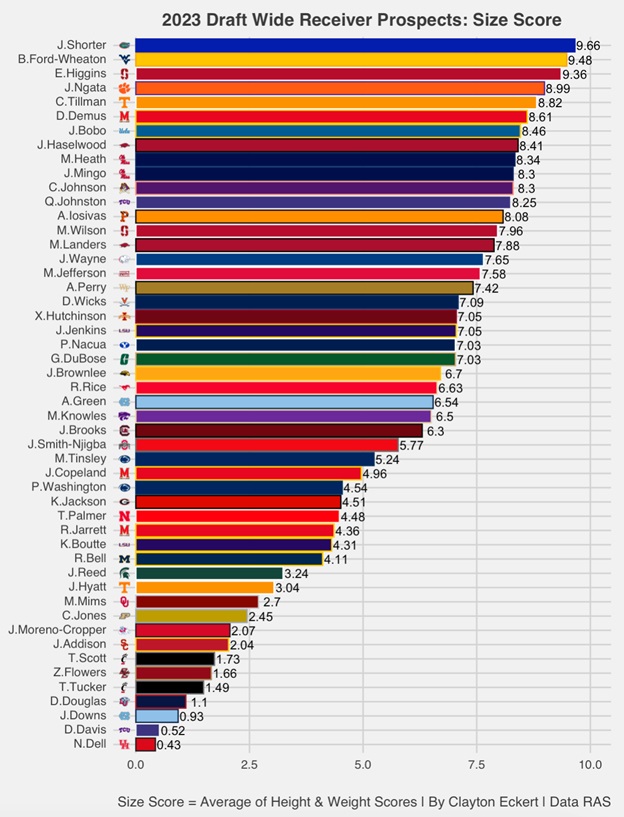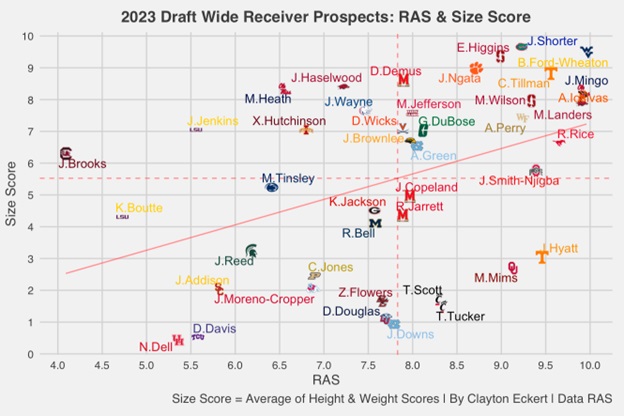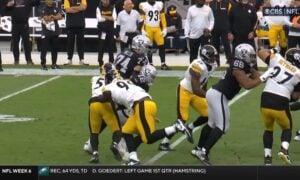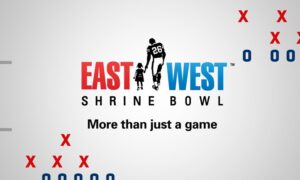Today I wanted to visualize some great data from Kent Lee Platt’s Relative Athletic Scores (RAS) for the wide receivers. Here is a link to his website in case you haven’t seen his work https://ras.football/. To qualify for a RAS score, a player must have a total of six recorded metrics from any of the following: Height, Weight, Forty-yard dash, Twenty-yard split, Ten-yard split, Bench Press, Vertical Jump, Broad Jump, Short Shuttle, and 3-Cone. The player is then graded on each in comparison to the positional database since 1987 to get more of a feel of their size, speed, explosion, agility, and total value, giving context to the raw numbers.
The goal of the series is to provide the RAS from Platt, with a bit of my own twist with a size score and visualize it to get a simultaneous view of all the players at their position that participated at the combine. Here are the players that qualified for a RAS (NOTE: Positions are grouped from the combine results tracker compiled by Dave Bryan and Alex Kozora):
12 of the 43 qualifying prospects have a RAS on nine or above, starting with West Virginia’s Bryce Ford Wheaton with a 9.96 RAS, who has elite size, speed, and explosion along with good agility, with his best mark coming in the vertical (41), and lowest mark coming in the three cone (6.97). Jonathan Mingo of Ole Miss has a 9.93 RAS, with elite explosion which is important for the position, great size and speed, faring best on the bench (22) and lowest mark was height (6016), but didn’t do agility testing. Andrei Iosivas of Princeton posted a 9.92 RAS, providing elite explosion, along with great size, speed, and agility, with his best coming in the 10-yard split (1.52) and lowest mark being weight (205). Arkansas Matt Landers’ 9.91 RAS caps a tight race of four players at the top of the ranks, and has elite speed, great explosion, along with good size with the 40 yard dash the highlight (4.37) and weight also his lowest mark (200).
After a bit of a drop off, we have SMU’s Rashee Rice (9.65 RAS) who has elite explosion, good size and speed, with the 10-yard split his best (1.49), lowest was height (6010), but didn’t do the agility testing. Cedric Tillman of Tennessee posted a 9.56 RAS with great size and explosion, good speed, with the broad jump his best (1008), lowest mark a 2.64 20-yard split, but didn’t do the agility testing. Tennessee teammate Jalin Hyatt comes in next (9.46 RAS, having elite speed and explosion but poor size, with his best mark the broad jump (1103) and lowest mark weight (176), and didn’t do agility testing. Jaxon Smith-Njigba of Ohio State (9.39 RAS) showed elite agility, good explosion, okay size, with his best the shuttle (3.93) and lowest being weight (196), but didn’t run the 40-yard dash. Stanford’s Michael Wilson (9.34 RAS) has great explosion, good size and speed, with his best coming on the bench (23) and lowest mark a 4.58 40-yard dash, but didn’t qualify for an agility score. A.T. Perry of Wake Forest (9.24 RAS) posted good size, speed, and explosion, but no agility testing, with the broad jump his best (1101) and weight the lowest mark (198). Florida’s Justin Shorter (9.23 RAS) has elite size, good explosion, okay speed, but no agility testing, with weight being his highlight (229) and the 20-yard split (2.66) his lowest. Marvin Mims of Oklahoma caps the 9+ RAS’s (9.13) with elite speed and explosion, but poor size and didn’t qualify for an agility grade, with a 4.38 40-yard dash being his best and weight the lowest (183).
Seven players have a RAS above eight, with Stanford’s Elijah Higgins topping that group (8.99) with elite size, good speed and explosion, did not qualify on agility, his best being weight (235) and three cone the lowest (7.01). Joseph Ngata of Clemson (8.72 RAS) has great size, good explosion, and okay speed, no agility testing, with weight being his best (217) and vertical jump his lowest (34.5), which is important for the position. After a bit of a drop off, Cincinnati’s Tre Tucker (8.35 RAS) has elite speed, great explosion, but very poor size and no agility testing, with an excellent 1.48 10-yard split and low result was height (5085). Cincinnati teammate Tyler Scott (8.3 RAS) posted elite explosion, great speed, but very poor size and no agility testing, with the broad jump his best (1101) and lowest was weight (177). Grant DuBose of Charlotte (8.12) has good scores across the board, with a 1.52 ten yard split his best and a 4.32 shuttle his lowest result. North Carolina’s Antione Green (8.05 RAS) has good size and speed, okay explosion and agility, with a 1.55 10-yard split his best workout and a 33.5 vertical his lowest. Michael Jefferson of Louisiana (8 RAS) posted elite explosion, good size and speed, but poor agility, with the broad jump his highlight (1101) and a 4.56 shuttle that is historically low.
12 players had a RAS of seven plus, starting with Jacob Copeland of Maryland (7.97 RAS) who has elite speed, good explosion, okay size, but poor agility, with his best being a 1.51 10-yard split and lowest a 4.47 shuttle. SMU’s Jason Brownlee also had a 7.97 RAS, with elite explosion, good size, but poor speed and no agility testing, his best a 1011 broad jump and worst mark a 1.61 10-yard split. Maryland’s Dontay Demus (7.9 RAS) has great size, good speed and explosion, but didn’t qualify in agility, with height his best mark (6030) and 4.39 shuttle the lowest. Dontayvion Wicks of Virginia (7.89 RAS) has elite explosion, good size, but poor speed and no agility testing, with a 1010 broad jump his best and a low 4.62 40-yard dash. Another Maryland product in Rakim Jarrett (7.89 RAS) has great speed, good explosion, but poor size and no agility testing, with a 4.44 40 yard dash his best and weight his lowest result (192). Josh Downs of North Carolina (7.79 RAS) posted elite explosion, great speed, but very poor size and no agility testing, with his 1.49 10-yard split his best and weighing very light (171).
Liberty’s Demario Douglas (7.7 RAS) has elite explosion, great speed, but very poor size and didn’t qualify in agility, with a great 1102 broad jump his highlight but very low historically in height (5080). Zay Flowers of Boston College (7.66 RAS) has great speed, good explosion, but very poor size and no agility testing, with his 4.42 40 yard dash his best workout and height the lowest (5090). Michigan’s Ronnie Bell (7.58 RAS) has good speed, explosion, and agility but poor size, with a 1.52 ten yard split his strongest result with height being his lowest (5115). Kearis Jackson of Georgia (7.57 RAS) has good speed and okay size, but didn’t qualify in explosion and no agility testing, with a 1.52 ten yard split his best and standing 5113 his lowest mark currently. South Alabama’s Jalen Wayne (7.47 RAS) has good size, okay speed, but didn’t qualify in explosion and no agility testing, with weight his best result (210) and 1.62 10-yard split the lowest. Jadon Haselwood of Arkansas (7.22 RAS) has great size, good explosion, with okay speed and agility, with weight his best mark (215) and a slow 4.66 40-yard dash.
After a drop off, we see six players with a RAS in the six range, starting with Purdue’s Charles Jones (6.89 RAS) who has good speed and explosion, but very poor size and no agility testing, with a 4.43 40 yard dash his highlight but low weight (175). Jalen Moreno-Cropper of Fresno State (6.88 RAS) has great speed, but very poor size, didn’t qualify in explosion and no agility testing, similarly with a 4.4 40 yard dash his best and low weight (172). Iowa State’s Xavier Hutchinson (6.79 RAS) has good size and speed, okay explosion and agility, with height his best result (6017) but a low 908 broad that is outside what Pittsburgh typically looks for. Malik Heath of Ole Miss (6.56 RAS) has great size, good explosion, okay speed, but poor agility, with a 1.53 10-yard split his best mark and a low 4.46 shuttle. Penn State’s Mitchell Tinsley (6.4 RAS) has good explosion, okay size and speed, but didn’t qualify in agility, with a 1.53 ten yard split his best but 4.6 40 yard dash. Jayden Reed of Michigan State (6.18 RAS) has great speed, okay explosion, but poor size and didn’t qualify in agility, with a 4.45 40 yard dash his best result and height (5110) his lowest.
Only four players land with an RAS in the fives, starting with USC’s Jordan Addison (5.82 RAS) who has good speed, okay explosion, but very poor size and no agility testing, with his 1.56 10-yard split being his best mark but very low weight (171). Deruis Davis of TCU (5.58 RAS) has elite speed, but very poor size, didn’t qualify in agility and no explosiveness testing, with a blazing 1.46 10-yard split but historically low weight (165). LSU’s Jaray Jenkins (5.56 RAS) has good size, okay speed, but didn’t qualify in explosion and no agility testing, with 20 reps on the bench his best mark currently but a 29.5 vertical jump his lowest, which is outside what Pittsburgh typically looks for. Nathaniel Dell of Houston (5.36 RAS) has great speed, but very poor size, didn’t qualify in explosion and no agility testing, with a 1.49 10-yard split his best mark but another historically low weigh-in (165).
Only two of the 43 prospects had a RAS in the fours, starting with LSU’s Kayshon Boutte (4.73 RAS) who has good speed, but poor size and explosion and didn’t qualify in agility, with his 4.5 40 yard dash his best mark (emphasizing his low RAS overall) along with a historically low vertical jump (29). Jalen Brooks of South Carolina has the lowest RAS of the group (4.09) with good size and explosion, but poor agility and very poor speed, with his only highlight being a 1010 broad jump, and lowest mark a slow 4.69 40 yard dash.
Next, I wanted to provide more context with a size score using the RAS for the players height and weight, which includes all the combine invites since all the players are measured:
There is more size in this year’s class compared to the 2022 draft, with 13 players above eight compared to seven last year. Topping the list is Shorter (6040, 229), and important to recall his good explosion (namely a 1006 broad jump) and okay speed. Ford-Wheaton is second (6040, 221) along with his top ranked overall RAS, pairing elite explosion and speed numbers along with good agility. Higgins (6030, 235) paired his elite size with a nice 1006 broad jump, with good marks otherwise.
Ngata starts the eight plus size scores (6031, 217) and had good and okay marks in the drills he participated in. Tillman (6033, 213) pairs his great size with great explosion, posting a 37 in the vertical jump and 1008 broad jump along with good speed. Demus (6030, 212) accelerated well with a 1.55 10-yard split along with good marks otherwise, but important to recall the low 4.39 shuttle as the exception. UCLA’s Jake Bobo (6040, 206) didn’t qualify for a RAS score, so he’ll be a name along with many others to monitor through the pro day process. Haselwood (6022, 215) paired his size with a nice vertical jump (37), with his low 40 time already mentioned, and to a lesser extent a poor 4.31 shuttle as well. Heath (6023, 213) topped his great size with the aforementioned strong 10-yard split, but had below average to poor results in the vertical (34), the 40 (4.64), 20-yard split (2.68), and shuttle (4.46). Mingo (6016, 220) had the second ranked overall RAS, pairing elite explosion along with his great size and speed. East Carolina’s C.J. Johnson (6014, 224) and TCU’s Quentin Johnston (6030, 208) didn’t qualify for a RAS, with the former only weighing in at the combine and the latter posting elite explosion numbers (40.5 vertical, 1102 broad) that are intriguing. Iosivas (6031, 205) ranked third in overall RAS, having a great overall workout and his weight ironically the lowest individual RAS score.
Ten players have size scores in the seven range (which is a good RAS rank), including Wilson (6017, 213) at the top with a strong overall 9.34 RAS, Landers (9.91 RAS), Wayne, Jefferson, Perry (9.24 RAS), Wicks, Hutchinson, Jenkins, DuBose, and BYU’s Puka Nacua (6020, 201) who didn’t test otherwise.
Five players have six plus size scores: Brownlee (6020, 198), Rice (9.65 RAS), Green, Kansas State’s Malik Knowles (6020, 196) who didn’t test at the combine, and Brooks who had the lowest overall RAS (4.09).
Two prospects land in the fives, Smith-Njigba (6010, 196) lower marks of his 9.39 RAS, and Tinsley (6.41 RAS).
An uptick to seven players land in the four range, including Copeland (5112, 201), Penn State’s Parker Washington (5100, 204) who only weighed-in, Jackson, Nebraska’s Tre Palmer (6000, 192) who didn’t qualify for an RAS but had elite speed with an impressive 4.33 40 yard dash, Jarrett, Boutte, and Bell (5115, 191).
Two prospects have size scores in the threes: Reed (5110, 187) and Hyatt (6001, 176) with the latter having a 9.46 RAS.
A whopping 11 players have size scores below three: Mims (5107, 183), Jones, Moreno-Cropper, Addison, Scott, Flowers, Tucker, Douglas, Downs, Davis, and Dell (5080, 165). Surprisingly, Mims was the only one with an above nine RAS, with only Scott and Tucker in the eight range, highlighting some lack of athleticism from this group of smaller statured players.
To wrap up, here is a visual layering the RAS and size score to take it all in:
There are several options that top the chart, highlighted by Ford-Wheaton and Shorter having above nine scores in both. Tillman, Mingo, and Iosivas round out the group of nine plus RAS and above eight size scores. Landers and Perry have a nine plus RAS with above seven size scores, while Rice and Smith-Njigba land above the mean in size and match in RAS. Several other players land above the mean in both, including Higgins, Ngata, Demus, Jefferson, DuBose, Wicks, Brownlee, and Green for a whopping total of 18 players, compared to eight in my article last draft season. Hyatt and Mims match in athleticism on the bottom right, important to note considering Pittsburgh’s recent drafting of George Pickens and Calvin Austin, who each topped a nine RAS with the latter having the lowest size score of the position in the 2022 draft.
For those that like the numbers, it’s unfortunate a few players didn’t test fully, and it will be interesting to monitor the pro days and continue to see how the men stack up in the coming weeks when Platt updates the site with the unofficial numbers.
What are your thoughts on the data? Thanks for reading and let me know your thoughts in the comments.

